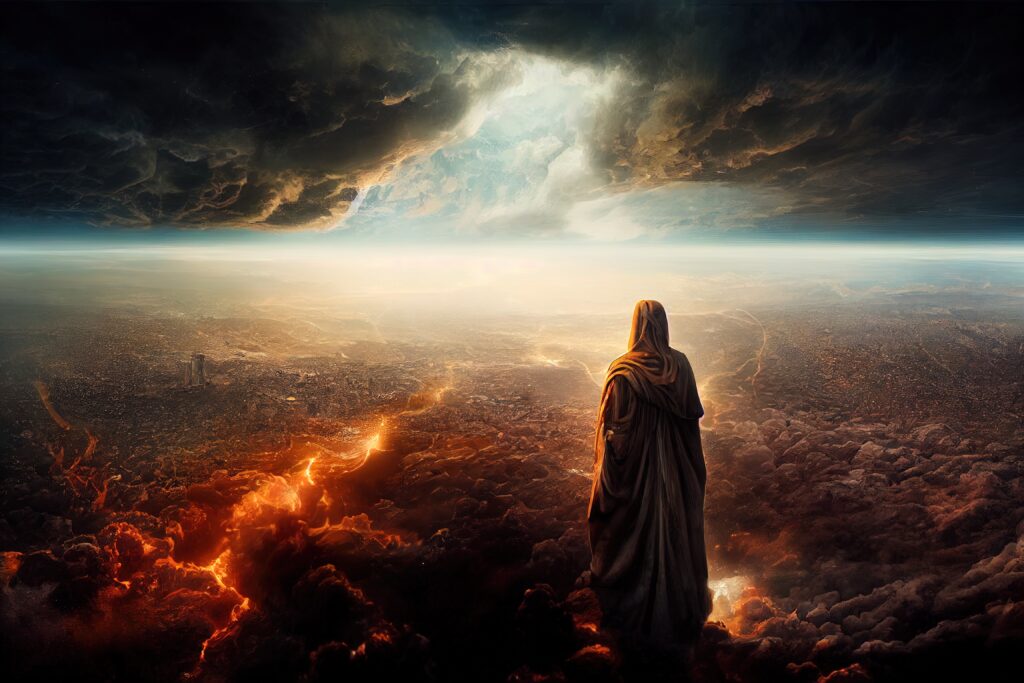
A Gruesome Reality; Eat or be Eaten.
And I saw the beast and the kings of the earth and their armies gathered to make war with the one sitting on the (white) horse and with his army. And the beast was captured, also the false prophet who performed miraculous signs before him (with these signs he deceived those who received the mark of the beast and worshiped his image). These two were thrown alive into the lake of fire which burns with sulphur. And the rest were killed by the sword that came out of the mouth of the one sitting on the (white) horse. And all the birds gorged themselves on their flesh. – Rev 19:19-21.
The gruesome reality of these images may make us feel uncomfortable. The thought of human beings burning in a fire or being penetrated with a sword is not pleasant. However, we know from the literature of the times, that the apocalyptic symbolic images of Revelation 19 resonated with that generation. God meets people where they are. The message of this violence is that sin and evil will one day be eliminated from the earth. Abuse and torture will end when the beast and the false prophet meet their end. It is like medicine for a sick world.
I teach my Science students about the discovery of antibiotics in the 1920s. Until then infections were like death sentences. Amazingly, even after the discovery of penicillin, it was still a decade before other scientists took notice of Fleming’s work, purified penicillin for mass production, and turned it into a miracle drug. Antibiotics are God’s tokens within the natural world that He will one day purify the universe from sin and evil.
Resistance to antibiotics occurs when people don’t finish the bottle. They take just enough of the medicine to feel better and then they stop. The problem is, the partial dose of antibiotic kills off the weaker bacteria in their system, but the remainder are strong enough to resist the next batch of antibiotics to some degree. If enough people take partial doses, new strains of bacteria may arise that are unaffected by the antibiotic.
By way of analogy, resistance to God’s saving work arises from free will.
God allows us to frustrate His work in our lives if we so choose. When we apply the gospel just enough to feel better but don’t take the full dose of its cleansing power, our resistance to the gospel gradually grows. Over time we are less and less affected by God’s call. The day may come when our resistance can only be overcome by the destruction illustrated in the passage of the day.
Yesterday, we noted that the description of Jesus includes three recognisable names: “Faithful and True”, “The Word of God,” and “King of Kings and Lord of Lords.” Names in the Bible are considered to be a summary of character. So, the names given to Jesus deserve to be given attention. Each has a significance of its own, answering every challenge that the devil has thrown against Him throughout time.
He is faithful. He keeps His promises both to condemn sin and redeem sinners. He is true because He acts with perfect justice and sublime mercy. He is King over all kings and Lord over all Lords. There is no ambiguity that Jesus, the human who lived on earth and died on the cross, is truly God Himself. And all three names combine in a trinity of Godliness. Typical of Revelation, however, in the middle of these three names being revealed, we are told that Jesus has a name that no-one but He knows. Truly, He is God revealed but, at the same time, beyond our complete comprehension. His character is beyond being captured by mere names.
In another dramatic contrast to the false worship that Babylon entails, Jesus is dressed in a robe dipped in blood: His own blood shed on Calvary. In a very telling contrast, the scarlet harlot in Revelation 17:6 is drunk on the blood of the saints. Jesus carries a sharp sword: reminiscent of Revelation 1:16 and Psalm 149:6, His word pierces the heart, dividing the soul and spirit (see Hebrews 4:12 where sword is the Word of God)). He also has a rod of iron (see also Rev 2:27 & 12:5), drawing on the image of justice in Psalm 2:9. We have seen Jesus in many roles in Revelation. Here He is depicted as the conqueror of sin and deliverer of justice to all those wronged by it.
The inverse of the “wedding supper of the Lamb” v9, is “the great supper of God” vs17-18, marking the destruction of the beast – false prophet alliance and their followers. To have your bones scattered by scavengers and not buried was considered the worst fate that could befall a person in the culture of the day, for if the bones were not collected together and guarded in a tomb, a resurrection was considered impossible. Thus, all involved in the beast-kingdom meet a final and permanent death.
